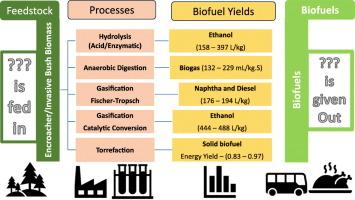Preliminary evaluation of biofuel production potentials for Southern Africa's encroacher and invasive bush biomass
Q1 Environmental Science
引用次数: 0
Abstract
The biofuel production potentials for encroacher and invasive bush biomass species found in Southern Africa were assessed using different valorization routes. Theoretical models were employed to calculate the biofuel yields. The gasification-catalytic route produced highest ethanol yields (450–488 L/t) while the lowest values were from enzymatic/acid hydrolysis-to-fermentation route. Blue gum gave the highest ethanol yields. Biodiesel and naphtha yields produced through Fischer-Tropsch synthesis were highest for blue gum (196 L/t) and lowest for Acacia raficiens (176 L/t). The highest biogas and biomethane potential of 458 L/kg.VS and 229 L/kg.VS respectively were obtained from black wattle while the respective lower values (270 L/kg.VS and 132 L/kg.VS) were recorded for blue gum. Senegalia mellifera gave the highest torrefied biofuel energy and mass yields at 0.92 and 0.97 respectively while black wattle had the lowest mass and energy yields at 0.75 and 0.83 respectively. From an energy yield basis, the acid hydrolysis-fermentation route yielded an average of 3.69 GJ/t of biomass while the highest yields came from the gasification-catalytic conversion route which was 9.7 GJ/t. The average energy yield variations across biomass species ranged 5.11–6.19 GJ/t which is around 30 % of the raw biomass' calorific value. These early results provide insights towards the best pairing of appropriate biomass species and energy conversion route. Further evaluations of these biomass-valorization technology pairing to unpack process efficiencies, cost and kinetics are required using real process experiments instead of using theoretical models. These additional tests should include sustainability assessment to guide future commercialization decisions.

南部非洲入侵和入侵灌木生物量生物燃料生产潜力的初步评价
采用不同的增值途径,对非洲南部发现的入侵和入侵灌木生物量物种的生物燃料生产潜力进行了评估。采用理论模型计算生物燃料产量。气化-催化途径乙醇产率最高(450 ~ 488 L/t),酶/酸水解-发酵途径最低。蓝胶的乙醇产量最高。蓝胶的生物柴油和石脑油产量最高(196 L/t),金合欢的生物柴油和石脑油产量最低(176 L/t)。最高沼气和生物甲烷潜能为458 L/kg。VS和229 L/kg。分别以黑荆树为对照,分别以270 L/kg为对照。蓝胶的VS和132 L/kg.VS)。黑荆的生物质能和质能产量最高,分别为0.92和0.97,黑荆的生物质能和质能产量最低,分别为0.75和0.83。从产能角度看,酸水解-发酵途径平均产能3.69 GJ/t,气化-催化转化途径产能最高,为9.7 GJ/t。不同生物量的平均产能变化范围为5.11 ~ 6.19 GJ/t,约为原料生物质热值的30%。这些早期结果为适当的生物质物种和能量转换途径的最佳配对提供了见解。进一步评估这些生物质增值技术配对,以揭示工艺效率,成本和动力学需要使用实际过程实验而不是使用理论模型。这些额外的测试应包括可持续性评估,以指导未来的商业化决策。
本文章由计算机程序翻译,如有差异,请以英文原文为准。
求助全文
约1分钟内获得全文
求助全文
来源期刊

Bioresource Technology Reports
Environmental Science-Environmental Engineering
CiteScore
7.20
自引率
0.00%
发文量
390
审稿时长
28 days
 求助内容:
求助内容: 应助结果提醒方式:
应助结果提醒方式:


